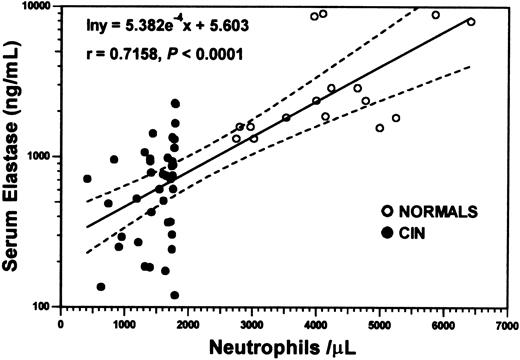Chronic idiopathic neutropenia (CIN) has been described as a persistent, unexplained reduction in the number of circulating neutrophils, below the lower limit of the normal distribution for a given ethnic population.1 The diagnostic criteria of the disorder have been presented elsewhere.2 The condition is characterized by low incidence of infections, usually benign outcome, female predominance, and an HLA class II genetic predisposition.3 In a recent study we showed that CIN patients display impaired granulocytopoiesis due to increased apoptosis of bone marrow (BM) CD34+/CD33+ granulocyte progenitor cells.4 Accelerated apoptosis of BM granulocyte progenitors also has been reported in patients with severe congenital neutropenia (Kostmann syndrome) and cyclic neutropenia. Recent evidence suggests that mutations in the ELA-2 elastase encoding gene may be involved in the pathogenesis of neutropenia in these neutropenic states.5 6 No related studies have been reported in CIN.
To test the hypothesis that abnormalities in neutrophil elastase might be implicated in the pathophysiology of CIN, we have studied neutrophil elastase in 39 white CIN patients (5 men and 34 women) aged 27 to 74 years (median, 52 years) and 16 age-matched and sex-matched healthy subjects. Specifically, we have measured serum neutrophil elastase levels by means of an enzyme-linked immunosorbent assay (ELISA) (HyCult Biotechnology, Uden, The Netherlands), and we also have looked for mutations in the ELA-2 elastase coding gene by performing genomic sequencing of polymerase chain reaction (PCR)–amplified exons and exon/intron junctions of DNA extracts from EDTA (ethylenediaminetetraacetic acid)–anticoagulated whole peripheral blood using an ABI/PE Biosystems PRISM Big Dye terminator chemistry on an ABI/PE Biosystems 310 Analyser (Applied Biosystems, Foster City, CA). Informed consent according to the Helsinki protocol was obtained from all subjects studied. Neutrophil counts ranged from 412 to 1795 (mean, 1475 ± 366 [SD]) per μL of blood in the patients and from 2747 to 6410 (mean, 4223 ± 1061 [SD]) per μL of blood in the controls. We found that CIN patients displayed significantly lower serum neutrophil elastase levels (mean, 757 ± 527 [SD] ng/mL; median, 711 ng/mL; range, 101 to 2276 ng/mL) compared to healthy subjects (mean, 3644 ± 3073 [SD] ng/mL; median, 2122 ng/mL; range, 1323 to 9325 ng/mL) (P < .0001, Mann-Whitney test). Individual serum neutrophil elastase values strongly correlated to the number of circulating neutrophils (r = 0.7158,P < .0001; Spearman test) (Figure1). No mutations in the critical regions of ELA-2 elastase coding gene were identified.
Strong correlation between the levels of serum neutrophil elastase and the number of circulating neutrophils in the entire group of subjects studied. The regression line is shown as a solid line, and the 95% confidence limits are shown as dotted lines. The equation, coefficient of correlation (r), and degree of significance (P) are indicated. CIN patients (●); healthy controls (○).
Strong correlation between the levels of serum neutrophil elastase and the number of circulating neutrophils in the entire group of subjects studied. The regression line is shown as a solid line, and the 95% confidence limits are shown as dotted lines. The equation, coefficient of correlation (r), and degree of significance (P) are indicated. CIN patients (●); healthy controls (○).
These data suggest that abnormalities in neutrophil elastase are unlikely to be implicated in the pathogenesis of CIN. The observed low concentration of the enzyme in patient sera probably reflects the low number of circulating neutrophils.7 The finding is not surprising, since potential elastase abnormalities are unlikely to have a pathogenetic role in mediating apoptosis restricted to the CD34+/CD33+ progenitor cell compartment. We conclude that although increased apoptosis of BM granulocyte progenitor cells may represent a common pathophysiologic mechanism underlying neutropenia in both acquired and congenital cases, distinct cellular and molecular defects are responsible for the increased susceptibility of BM granulocyte progenitors to apoptosis in these neutropenic states.



